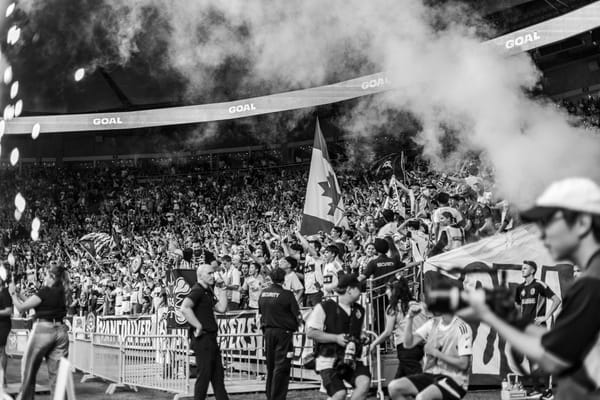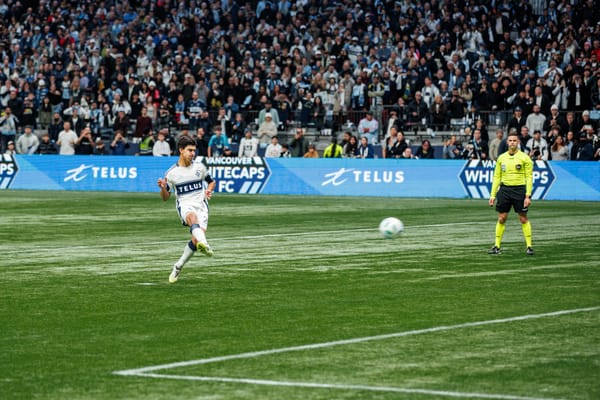The #GioOut Debate- Part 2
The second part in a three-part series on the tenure of Giovanni Savarese- focusing more on analysis of his teams
For Part 1, click here.
Thanks for reading Cascadia FC's Substack! Subscribe for free to receive new posts and support my work.
On-The-Field Analysis Part 1: A Player’s Manager
Savarese’s list of accomplishments with Portland is impressive. Besides both MLS Cup runs (both of which have earned trophies), he has MLS is Back and the 2022 Cascadia Cup to his name. That is the essence of Savarese’s term here. No matter what, we are always competitive at the end of the season. Last year’s playoff miss was the first in his tenure with the club. He also hasn’t had the easiest job off the field either. No one could have predicted Fernandez’s problems with cocaine (except maybe Gavin Wilkinson but his list of sins stretches all the way to Astoria) or the fallout from Andy Polo’s domestic violence case. He has also had to deal with a plague of injuries that never seems to end. His fully healthy teams always compete on the highest level. But coaches in MLS have a barrier that coaches in Europe don’t have to deal with: roster limits. MLS teams are always hard-pressed for depth especially if injuries are a major factor. Throughout the roster limits that Savarese has had he has managed to keep the Timbers competitive, even if it isn’t pretty. He is a man who knows how to win games, and the players love him for that. His consistent ability to grind out results is a quality of a good man manager. Look at Zinedine Zidane’s tenure in Madrid. He had great players who had very high soccer IQ and he managed them to perfection. Winning three Champions Leagues in a row is incredibly impressive. He was able to get the most out of his players without a clearly defined tactical system. Savarese is that style of coach.
Now, that style comes with a weakness. Since Savarese arrived in Portland, he has presided over the primes of three club legends. Valeri had just won the MVP in 2017, Blanco was in his second season here, and Diego Chara had already established himself as the best DM in MLS. Because of that, the Timbers have become a team that will go as far as their best players take them. Valeri was nicknamed El Maestro for a reason. He coordinated the attack through the first couple years of Savarese’s tenure, and once his age began to show Blanco picked up the torch. Blanco, of course, got hurt in 2020, but once he returned in 2021 the team played inspired soccer all the way to a MLS Cup Final. That 2021 final is still Savarese’s defining match as Timbers manager. Blanco had tweaked his hamstring in the conference semifinal win in Colorado, and missed the following week’s victory over RSL. Dairon Asprilla was shown a red card in the dying moments of the Colorado match, and he also missed the RSL game serving his suspension. The three advanced midfielders who started against RSL (Yimmi Chara, Marvin Loria, Santiago Moreno) showed great chemistry together in that victory. However, both Blanco and Asprilla started the following week in the final. Both players were rusty for various reasons (Asprilla was not mentally in match shape and Blanco was still obviously hurt) and they were unable to create the same spark in attack that the RSL starters had created the week before. He decided to go with his big name players rather than sticking with the success from the previous week. Now, if the players look healthy in training, and they are also performing well in training, it is a perfectly fine job to play them in the biggest game of the season. MLS is a star’s league, and stars often carry teams to the highest honors in the league. Was starting Asprilla and Blanco the reason we lost MLS Cup? I think it is a factor, but there were so many other factors that day that led to our loss. It shouldn’t be understated how lifeless we looked in the first half though, and a lot of that was due to Asprilla and Blanco.
On-The-Field Analysis Part 2: Lack of Tactical Identity & Misidentification of Talent
That decision to start them is the nexus of Savarese’s biggest weakness: relying too much on top-tier talent rather than tactics. Last year, a tactical shift was incredibly necessary as the creativeness of the side was nonexistent. Goals needed to come from set pieces, penalties, and counter-attacks because there were so few quality chances being created in possession. Last year was also the first year the Timbers didn’t have a true healthy number ten for the entire season. Yimmi Chara was forced into that role, but it wasn’t his natural position and his performances suffered because of it. Blanco still had a good year, but the reaggravation of his hamstring limited him. Thus the Timbers were without their star for the first time in Savarese’s tenure. Switching to the back five at the end of the season was a move made to get results by emphasizing a stronger defense to make up for the weakened attack. This was the same story from 2020 as well. Even 2019 to an extent, with Fernandez being the focal point. And this misidentification of Fernandez’s talent was the first domino to fall that has led us to this exact moment in Timbers history.
Fernandez primarily played on the right for Necaxa. He was a dangerous winger with a serious eye for goal. Savarese, however, saw him as a number 9. He has stuck with his prized 4-2-3-1 formation for the majority of his tenure, and that formation only has a single striker leading the line. This created a problem for Jeremy Ebobisse. A college standout at Duke, Ebobisse was drafted by Portland in the first round of the 2017 MLS SuperDraft. He quickly earned a spot with the first team, showing good scoring instincts and even better skills off the ball and in hold-up play. He looked like a true number 9. That made it more confusing when Savarese began deploying him on the left wing after Fernandez arrived. Surely Gio could see that they had a fantastic attack, with Valeri at the ten, Blanco able to both pull the strings and arrive late in the box on the left, Fernandez free to make lethal late runs and finish with deadly accuracy, and Ebobisse able to hold-up play and score from deliveries from Blanco, Valeri, and attacking minded fullbacks Jorge Villafana and Jorge Moreira? But he decided to play Fernandez as a striker, and once teams could figure out how to stop him, the attack stalled. I remember attending the July 18, 2019 match at home against Orlando City. The Timbers dominated the game, but only came away with a 1-1 draw. They recorded 63% possession, outshot Orlando 26-2, and tied. Out of those 26 shots, 17 were inside the box, and only 4 were on target. They completed 488 passes that day, with 342 in the attacking half of the field. The defining stat of that match, however, was accurate crosses. The Timbers fired 41 crosses into the opposing box, and only connected on 9 of them. That’s a rate of 22 percent. Ebobisse didn’t start that match, but he came on as a sub for Andy Polo on the left wing. He ended up scoring the equalizer when one of those 9 accurate crosses found the head of a diving Fernandez, who popped it back up right onto Ebobisse's head for a true striker’s finish. Why are 41 crosses being sent into the box to a short number 9, while the proper number 9 is playing on the left wing? I don’t have an issue with all the crossing as Orlando was very much parking the bus on the road. But there is something to be said about having the right players in the right positions for that situation, and Savarese did not. Further down the line, Fernandez was suspended by the league and eventually released by Portland. What did the Timbers do in response? What position did they end up strengthening? They brought in two new high-salary strikers. Now, front offices and coaching staffs are supposed to communicate. The coach’s job is to let the general manager know what positions he thinks need help, and the GM’s job is to bring qualified players to the coach’s attention so they can agree on a signing. Savarese still didn’t see Ebobisse as the number 9 that he was. So here come two new strikers, in a system that only uses one on the field at a time. Not that they were bad signings as players, mind you. Both of them when healthy were top players in the league (don’t judge Niezgoda as a bad signing, that injury was very unfortunate and he hasn’t been able to move the same since). But in 2021, with this increased depth and salary committed to the striker position, Ebobisse became expendable as he entered a contract year. Why sign two big-salary strikers when the number 9 you have been looking for has been here the whole time? Both signings reek of desperation following Fernandez’s $9 million move collapsing. But it wasn’t just desperation. It was the most significant misjudgement of talent in Timbers MLS history. Ebobisse was traded to San Jose for a million bucks worth of GAM. Since then, the Timbers have had a massive hole at the striker position, while Ebobisse has looked like the number 9 he was always meant to be in San Jose. 17 goals in 34 matches last year in his first full season with the Quakes. In 2022, all the strikers in Portland combined for 12 goals. You can still score without a healthy number ten if you have a competent striker who can create and score goals on his own. That player is now a Golden Boot contender, playing for a Western Conference rival.
On-The-Field Analysis Part 3: In-Game Management
The other massive knock on Savarese is his in-game management. He has a habit of dropping points in late-game situations. Some of those lost points are directly caused by his substitution habits. This primarily popped up in the past year, and I will use a match from last year to illustrate this. It was the first match following the June international break in Los Angeles (Carson, to be exact). The Timbers had grabbed the early lead following a Yimmi Chara goal. They weren’t creating a ton of quality chances, and seemed to be on the back foot in the second half. Center back Larrys Mabiala looked particularly vulnerable, and it looked like an equalizer could come at any moment for the host Galaxy. Savarese used four substitutions that day, and all four were attackers. Nathan Fogaca entered at the 60th, Marvin Loria and Dairon Asprilla at the 73rd, and Felipe Mora made his season debut in the 85th. All four of the Portland front line were subbed off. Now, I understand wanting to get the second and completely kill the game off, but the tide was not in the Timbers’ favor. There were defensive options on the bench, with Zac McGraw and David Ayala chief among them. But why swap out four attackers with a 1-0 lead? Especially when the defense is looking very vulnerable? Dejan Joveljic finally scored the equalizer in the 88th minute. But that wasn’t the whole story. The Timbers were lucky to escape with a point at all. A foul was called that wiped out a potential Galaxy winner, but the Timbers should never have been in that spot to begin with. Those dropped 2 points were the difference in the Timbers missing the playoffs, as they finished 1 point behind 7th-place Real Salt Lake. There were other instances of dropped points, like the Dallas home game (pain pain pain pain), but that particular match could be chalked up to dumb luck. There are more instances of his substitutions seemingly not making sense, but that Galaxy game is the most glaring example. Through the first four games of 2023, this seems to have improved a little bit. A tactical shift mid-match against LAFC led to the Timbers nearly capturing a point down 3-0. Even though the shift was positive, an argument could be made that Savarese took too long to implement it.
This also plays into another weakness: waiting too long to make substitutions. I understand the importance of giving players proper minutes, but sometimes it just might not be their day. Savarese has a habit of making his first subs in the 65-70 minute window. By then, the majority of the game has passed, and now the subbed-on players don’t have a ton of time to grow into the game. This point doesn’t need a ton of expansion, because it’s rather simple. Those match-changing substitutions against LAFC came in the 60th, and the next one came in the 72nd, when Nathan Fogaca replaced a feckless Jaroslaw Niezgoda. That’s an example of Savarese properly using his substitutions. Subs-wise, St. Louis is only notable because Cristhian Paredes’ injury facilitated an early sub, which is something you can’t plan for. Savarese still only used 4 subs, with two of those coming in the 81st minute, 6 minutes after St. Louis took the lead. Urgency would’ve been welcome in that situation as well. This is something that I have seen improvement on so far this season, so I’m happy to acknowledge the progress he has made here with an emphasis on continued improvement.
Off-The-Field Analysis: The Locker Room Leader
Now, that was a lot of criticism, and all of it has to do with on the field performance, not results. Off the field, Savarese is a great person. He has full control of the locker room. That is evidenced by the seemingly annual turnaround this team does to find their best form in the latter months of the season. He is also a paragon of stability on the field amidst all the off-field turbulence in the club’s front office. There is a video that replays in my mind an awful lot. It is the Timbers celebrating their away win in Seattle last year, with Savarese leading a rendition of the Timbers Army trademark cheer, “Green and Gold.” The rest of the squad joins in, with the tune being correct but the words absolutely butchered. The response from Timbers fans? “Get him a chant sheet.” Possibly firing a manager that is beloved in the locker room is an objectively bad idea. Especially a team that still looks very similar to the team Savarese inherited in 2018. Several key depth pieces and current starters have spent multiple years with this team. Between the continuity and the results, moving on from Savarese objectively doesn’t look like a good idea.
Part Three will be out sometime next week, with my final verdict on this situation. Don’t forget to subscribe to get it directly in your inbox the moment it releases.
Thanks for reading Cascadia FC's Substack! Subscribe for free to receive new posts and support my work.




